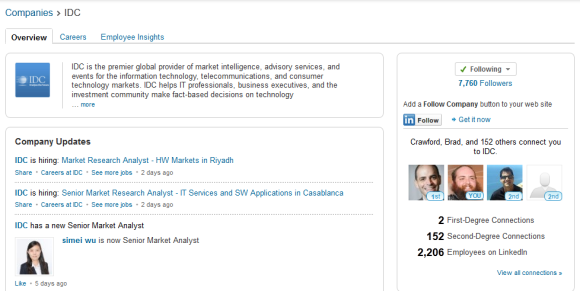 Image: Thinkstock
Image: ThinkstockIf you listen to conventional wisdom, LinkedIn is a vast sea of potential hires, all just waiting to jump onboard your company. The good news: LinkedIn indeed holds deep recruiting potential. The bad news: Rock star candidates won’t start banging on your door just because you’ve whipped together a basic LinkedIn profile.
As with all recruiting efforts, mining LinkedIn for talent takes time and effort. Here’s how your business can tap into the world’s largest professional network and find the right person for the right job.
First, let’s start with some basic stuff.

1. It all starts with you. LinkedIn is built around connections. The more people you (and your HR staff) know, the larger your extended network becomes, opening up the ability to see the names and bios of your connections’ connections, and even people you have three degrees of separation from. In other words, don’t be bashful.
2. Don’t forget the social aspect. If you only use your LinkedIn connections to gain access to someone’s network, your recruiting attempts will basically end up being like cold calls. After you identify a potential job candidate, prime the pump by asking your mutual friends to arrange an introduction.
3. Use your status updates wisely. Share that you’re looking to fill an open position in the “Share an update” section of the LinkedIn homepage and see if your contacts can refer somebody your way. Likewise, pay attention to the flow of LinkedIn Updates coming from your contacts on the LinkedIn homepage; people often advertise there when they or their friends are available for hiring.

4. Create a company page. Adding a company page helps job seekers easily find your contact information and allows people to follow updates from your business. Be sure to announce when you’re hiring.
5. Post a job listing. Listing a job opening costs a few hundred dollars a month, depending on your company’s location. In Boston, for example, a basic 30-day job posting costs $295.
6. Serve up targeted ads. LinkedIn Recruitment Ads have fine, granular targeting capabilities that can spotlight your company for the types of candidates you pinpoint. The ads even list personal contacts that can introduce the potential recruit to your business.
That’s the easy part. Now for some more advanced headhunting tips.

7. Use LinkedIn’s advanced search features. The advanced search functions (found to the right of the Search box at the top of the screen) include granular search criteria similar to the targeting capabilities of LinkedIn Ads, which allows you to search for profiles that include very specific elements. Anyone can search by postal code, job title and even schools attended, but you’ll need to upgrade to a premium account (starting at $19.95/mo.) for access to even finer search capabilities, such as filters for seniority levels and years of experience
8. Don’t forget keyword searches. The advanced search function includes a “keyword” field that looks for specific terms in people’s profiles, helping you to narrow down the signal-to-noise ratio when you’re searching for potential hires.

9. Recruiting ninjas use additional advanced search operators. Straightforward searches work decently well, but if you want to really start drilling down to find ideal job candidates, use specially worded advanced search operators to scout out LinkedIn members. It’s a complicated subject, but one that’s fairly simple to get a basic handle on: Social Talent has excellent overviews of advanced LinkedIn search terms and how to get great results from advanced keyword searches, while Boolean Black Belt offers a tremendous tutorial on how to use advanced searches to limit your LinkedIn searches to people who are actively looking for jobs.
10. Try searching on Google, instead. While LinkedIn’s built-in search engine offers the most accurate profile search results, it has a drawback: You can’t see full names of qualified candidates outside your personal network unless you pay at least $400/month. for a LinkedIn Recruiter account. Using Google (and advanced search operators) to scour public LinkedIn profiles skirts around that issue; clicking on a candidate’s profile from Google brings up their full name. Once you’ve identified a promising candidate, you can send him an InMail or contact him outside of the social network. RecruiterFiles features a basic primer on mining LinkedIn with Google.

11. Convince hesitant prospects. If you’re actively mining LinkedIn for talent, many of the potential hires you reach out to will probably be “passive” candidates who aren’t actually looking for a job. LinkedIn’s recruiting blog has a handy interview with a senior recruiting manager for a major digital PR firm that offers insightful tips on how to coax passive prospects out of their shells.